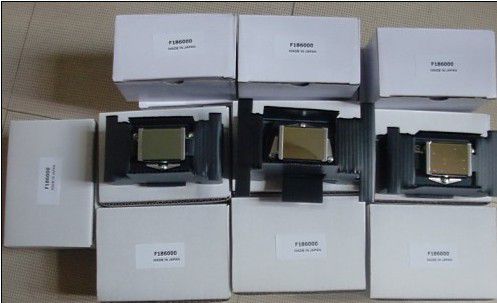There are two main design philosophies in inkjet head design: fixed-head and disposable head. Each has its own strengths and weaknesses.
The fixed-head philosophy provides an inbuilt print head (often referred to as a gaiter- head) that is designed to last for the life of the printer. The idea is that because the head need not be replaced every time the ink runs out, consumable costs can be made lower and the head itself can be more precise than a cheap disposable one, typically requiring no calibration. On the other hand, if a fixed head is damaged, obtaining a replacement head can become expensive, if removing and replacing the head is even possible. If the printer's head cannot be removed, the printer itself will then need to be replaced.
Fixed head designs are available in consumer products, but are more likely to be found on industrial high-end printers and large format plotters. In the consumer space, fixed-head printers are manufactured primarily by Epson and Canon; however, many more recent Hewlett-Packard models use a fixed-head, such as the Officejet Pro 8620 and HP's Pagewide series
The disposable head philosophy uses a print head which is supplied as a part of a replaceable ink cartridge. Every time a cartridge is exhausted, the entire cartridge and print head are replaced with a new one. This adds to the cost of consumables and makes it more difficult to manufacture a high-precision head at a reasonable cost, but also means that a damaged or clogged print head is only a minor problem: the user can simply buy a new cartridge. Hewlett-Packard has traditionally favoured the disposable print head, as did Canon in its early models. This type of construction can also be seen as an effort by printer manufacturers to stem third party ink cartridge assembly replacements, as these would-be suppliers don't have the ability to manufacture specialized print heads.
An intermediate method does exist: a disposable ink tank connected to a disposable head, which is replaced infrequently (perhaps every tenth ink tank or so). Most high-volume Hewlett-Packard inkjet printers use this setup, with the disposable print heads used on lower volume models. A similar approach is used by Kodak, where the printhead intended for permanent use is nevertheless inexpensive and can be replaced by the user. Canon now uses (in most models) replaceable print heads which are designed to last the life of the printer, but can be replaced by the user should they become clogged.
The primary cause of inkjet printing problems is ink drying on the printhead's nozzles, causing the pigments and dyes to dry out and form a solid block of hardened mass that plugs the microscopic ink passageways. Most printers attempt to prevent this drying from occurring by covering the printhead nozzles with a rubber cap when the printer is not in use. Abrupt power losses, or unplugging the printer before it has capped the printhead, can cause the printhead to be left in an uncapped state. Even when the head is capped, this seal is not perfect, and over a period of several weeks the moisture (or other solvent) can still seep out, causing the ink to dry and harden. Once ink begins to collect and harden, the drop volume can be affected, drop trajectory can change, or the nozzle can completely fail to jet ink.
To combat this drying, nearly all inkjet printers include a mechanism to reapply moisture to the printhead. Typically there is no separate supply of pure ink-free solvent available to do this job, and so instead the ink itself is used to remoisten the printhead. The printer attempts to fire all nozzles at once, and as the ink sprays out, some of it wicks across the printhead to the dry channels and partially softens the hardened ink. After spraying, a rubber wiper blade is swept across the printhead to spread the moisture evenly across the printhead, and the jets are again all fired to dislodge any ink clumps blocking the channels.
Some printers use a supplemental air-suction pump, using the rubber capping station to suck ink through a severely clogged cartridge. The suction pump mechanism is frequently driven by the page feed stepper motor: it is connected to the end of the shaft. The pump only engages when the shaft turns backwards, hence the rollers reversing while head cleaning. Due to the built-in head design, the suction pump is also needed to prime the ink channels inside a new printer, and to reprime the channels between ink tank changes.
Professional solvent- and UV-curable ink wide-format inkjet printers generally include a "manual clean" mode that allows the operator to manually clean the print heads and capping mechanism and to replace the wiper blades and other parts used in the automated cleaning processes. The volume of ink used in these printers often leads to "overspray" and therefore buildup of dried ink in many places that automated processes are not capable of cleaning.
The ink consumed in the cleaning process needs to be collected to prevent ink from leaking in the printer. The collection area is called the spittoon, and in Hewlett Packard printers this is an open plastic tray underneath the cleaning/wiping station. In Epson printers, there is typically a large absorption pad in a pan underneath the paper feed platen. For printers several years old, it is common for the dried ink in the spittoon to form a pile that can stack up and touch the print heads, jamming the printer. Some larger professional printers using solvent inks may employ a replaceable plastic receptacle to contain waste ink and solvent which must be emptied or replaced when full.
Labyrinth air vent tubes on the top of an Epson Stylus Photo 5-color ink tank. The long air channels are molded into the top of the tank and the blue label seals the channels into long tubes. The yellow label is removed prior to installation, and opens the tube ends to the atmosphere so that ink can be sprayed onto the paper. Removing the blue label would destroy the tubes and cause the moisture to quickly evaporate
There is a second type of ink drying that most printers are unable to prevent. For ink to spray from the cartridge, air must enter to displace the removed ink. The air enters via an extremely long, thin labyrinth tube, up to 10 cm long, wrapping back and forth across the ink tank. The channel is long and narrow to reduce moisture evaporation through the vent tube, but some evaporation still occurs and eventually the ink cartridge dries up from the inside out. To combat this problem, which is especially acute with professional fast-drying solvent inks, many wide-format printer cartridge designs contain the ink in an airtight, collapsible bag that requires no vent. The bag merely shrinks until the cartridge is empty.
The frequent cleaning conducted by some printers can consume quite a bit of ink and has a great impact on cost-per-page determinations.
Clogged nozzles can be detected by printing a standard test pattern on the page. Some software workaround methods are known for re-routing printing information from a clogged nozzle to a working nozzle

Contact: Betty Wong
Phone: +0086 15018500959
Tel: +0086 15018500959
Whatsapp: +0086 15018500959
Email: Betty@myjprinter.com
Add: Jinduhui Building,Xueyuan Street,Yanhu District,Yuncheng,Shanxi (No.263, Bridge West, Fuyong Qiaotou, Baoan District, Shenzhen)
We chat
